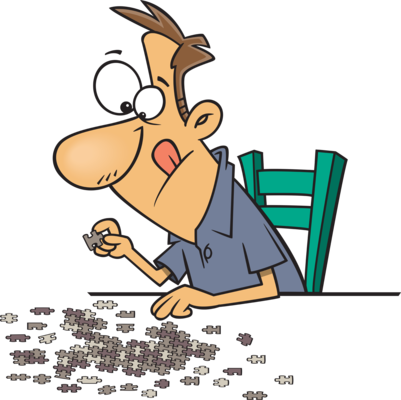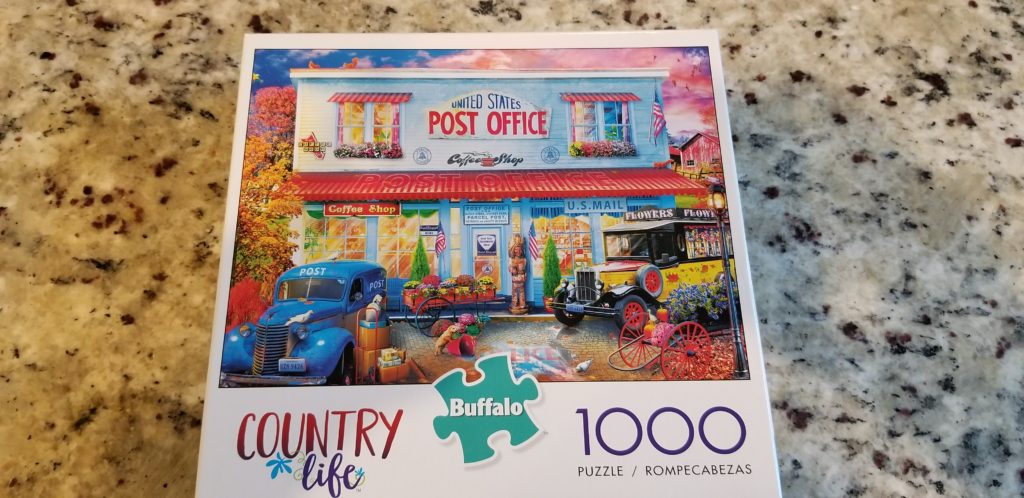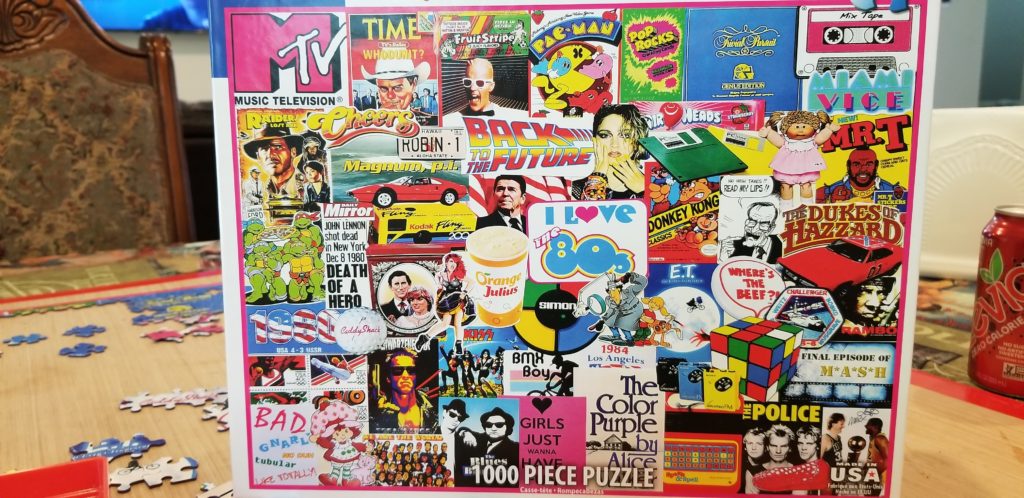
Piecing It All Together: A Beginner’s Guide
Part One: Image Choice
In the years I have been part of the online, social media-based puzzling groups, I have come to discover a common theme. Beginning level puzzlers often give up on a new hobby they might thoroughly come to love and have an intense passion for because of one simple and easily correctable mistake – they chose the wrong puzzle image to start with as a novice.
What do I mean by that you ask? Well here is a good visual of two puzzles which a beginner would be better off running away from rather than toward at first.
On the left is a gorgeous 1000-piece Eurographics puzzle which is very dark, and has almost no color variation besides grey, darker grey, and more grey with a few pieces of white (the lightning bolts) and green (the tree and grass) thrown in for good measure. Out of the 1000 pieces, the non-grey pieces make up maybe 150 – 200 pieces. So that leaves 800 – 850 shades of grey (way more of a nightmare than the movie I can assure you! LOL)
With 800+ pieces of mostly dark to slightly less dark shades of one color, you are forced to either sort by piece shape (if you are of the sorting type — *wink wink Gus*), or brute force your way through trying one piece at a time until something fits. Then on to the next piece – so on and so forth 849 more times! At that rate, the puzzle will take a very long time to complete, if ever.
The puzzle on the right is also a 1,000-piece nautical beauty that I can see why someone who is into boats / ships would gravitate toward in a heartbeat. It’s beautiful too, but its also dark, dark, and the mast! That’s pretty much it for this one. Even assembling the border on this, which almost every new puzzler (and many, many experienced puzzlers) do, would be a huge challenge, and therefore, likely to be one they will become frustrated with and give up on soon after starting.
Why, as a person who has perhaps not touched a puzzle since childhood or ever in their lifetime, want to start with a puzzle like these or other images which only have one or two areas of distinct color? In my mind, this is setting oneself up for failure, discouragement, frustration, and possibly even a feeling of inadequacy. Puzzling should never make you feel ANY of these things. Puzzling should above all be fun and relaxing. In my mind at least, nothing about either of these two puzzles would be relaxing.
On the other hand, compare those above to these next two and see if you think either of these would cause anxiety when it comes to having large areas of solid color.
The one on the left is a simple, easy image with lots of color and details. One could start with sorting the pieces into piles for the blue truck…the building…any words…foliage, etc. By separating those out and assembling them first, it’s not so overwhelming on where to start and what to focus on completing first. By breaking the puzzle down this way, you’re taking bite sized pieces which you can then build upon once you’ve done a few. Once you have completed the truck, you’ll see that you might be able to connect in some of the foliage pieces to it. Making those connections is highly satisfying and before you know it, you’ll have completed a bunch of small sections that can be attached together and you will be delighted to see that more than half the puzzle is done already! It’s one of the best feelings.
The puzzle on the right is a typical White Mountain Puzzle collage image. There are so many fun details in this image that not only is it just about impossible to get bored, it’s a puzzle you can almost assemble as 40 or more different images if you really want. You can choose to start with the Blues Brothers part, or assemble the General Lee or even Princess Di and Prince Charles. In my mind, collages like this are the easiest and best beginner’s puzzle choice. They’re fun and easy.
As you complete puzzles, your skill set will grow. Soon you’ll be much more savvy about the piece shape that is most likely to fit in any particular spot and thereby shorten the time it takes to find the right piece. You’ll also be better able to distinguish subtle differences in shade — like between a darker blue and purple. And once that skill set is acquired, you’ll also be able to more quickly determine what is a piece with tree leaves vs. grass. At that point you’ll be off to the races and have a much higher rate of success when you go to tackle a puzzle that is nothing but fields of flowers, snowy mountains, or even 800+ shades of grey.
In Part Two, I will focus on the border — doing it initially vs. later on as you know more about the image.




7 thoughts on “Piecing It All Together: A Beginner’s Guide”
Good advice Puzzle Momma, thanks.
You are welcome, wojigsaws! Always happy to help. Are uou a new puzzler?
Off and on over the years. More so now. There are so many resources available online now that makes this pastime so much more interesting. Including your site 🙂
Excellent advice. I’ve chosen a 1000 piece collage puzzle from White Mountain which is really about 50 smaller discrete images and I’m proceeding with great pleasure and no bafflement.
Yay! That is wonderful Natalie! Collages are always an excellent place to start your new journey. Best of luck and please share a pic on here when its done. Would love to see the results of your fantastic efforts.
Thank you! I am not sure how to add an image. I did a wonderful Pomegranate Covers of Edward Gorey and a delightful White Mountain Yankee Magazines covers.
Oh very cool. White Mountain puzzles are the best collages!